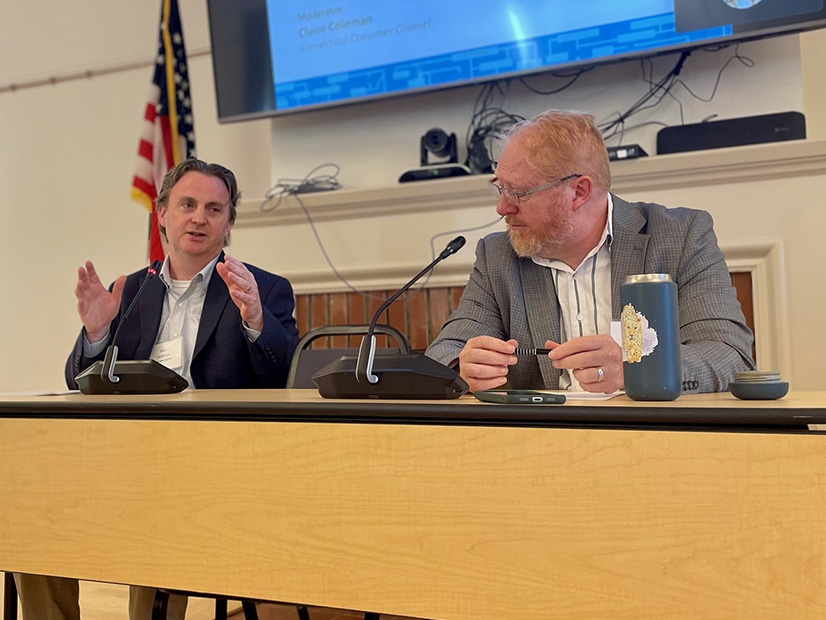NEW LONDON, Conn. — Activists, ISO-NE officials and state representatives from across New England convened in this port city to discuss the benefits of offshore wind to the region’s power system — along with the challenges to deployment — at the RTO’s Consumer Liaison Group meeting Sept. 12.
The New London port is one of the region’s key staging areas for offshore wind. It was used as a staging and assembly point for the South Fork Wind Farm and is currently supporting the construction of the Revolution Wind project.
“We are bringing this industry to America,” said Ulysses Hammond, the recently retired executive director of the Connecticut Port Authority, kicking off the meeting.
Speakers at the CLG generally spoke favorably of the significant reliability, climate and public health benefits that offshore wind could provide the region, while citing costs and transmission challenges as the key factors that could slow its deployment.
While New England states have set ambitious offshore wind goals, high costs have caused project cancellations and smaller procurements than many advocates have hoped for. Massachusetts and Rhode Island recently announced their selection of 2,878 MW from their multistate coordinated procurement, which initially sought up to 6,000 MW. (See Multistate Offshore Wind Solicitation Lands 2,878 MW for Mass., RI.)
Connecticut, which also participated in the coordinated procurement, announced that it is still evaluating the bids, putting into question the viability of one project selected by Massachusetts. (See NY OSW: If at First You Don’t Succeed, Try, Try Again.)
Although high bid prices appear to have given some lawmakers second thoughts, offshore wind PPAs will likely save ratepayers money in the long run, said Josh Berman, senior attorney at the Sierra Club.
He highlighted the results of a recent analysis commissioned by the Sierra Club that found that adding 9 GW of offshore wind would save the region an estimated $630 million annually due to lower market clearing prices. The estimate was based on a $150.15/MWh project cost, derived from the Sunrise Wind and Empire Wind projects. Massachusetts and Rhode Island have not yet announced the costs associated with their most recent solicitation. (See Offshore Wind Projected to Save New Englanders $630M per Year.)
Adding 9 GW of wind would also cut the region’s power sector emissions by about 42% and provide about $362 million in annual public health benefits due to lower NOx and particulate emissions, Berman said.
Berman emphasized that the benefits would be socialized across the region’s grid, even though the current PPA model largely revolves around individual states — or pairs of states — covering the entirety of a project’s costs. He compared the dynamic to Connecticut’s support of the Millstone nuclear plant and said collaboration and cost sharing between New England states will be a key component moving forward. (See Connecticut Zero-Carbon Awards Include Nukes, OSW, Solar.)
Susan Muller, senior energy analyst at the Union of Concerned Scientists (UCS), said offshore wind will also provide significant winter reliability benefits, as it typically performs better in lower temperatures. She highlighted a recent UCS analysis that found offshore wind additions would significantly reduce winter blackout risks in the region, echoing the findings of recent ISO-NE studies. (See ISO-NE Study Highlights the Importance of OSW, Nuclear, Stored Fuel.)
Muller added that ISO-NE’s inventoried energy program and Mystic cost-of-service agreement, both aimed at ensuring winter resource adequacy, have cost ratepayers nearly $1 billion. And while Enbridge has proposed a significant gas capacity expansion into the region to reduce winter gas constraints, Muller said it makes far more sense to invest in offshore wind resources.
“If you’re thinking about a new gas pipeline, you first need to talk with the communities that it is going through,” Muller said. “The pipeline really seems to be the wrong path to take. Because we have offshore wind as an incredible opportunity before us, we think it’s a no-brainer to go down the other path.”
Liz Mettetal, a director at the consulting firm Energy + Environmental Economics (E3), said offshore wind and long-duration storage will have combined reliability benefits that are “greater than the sum of their parts” as both technologies scale up.
Mettetal said the region should consider timing storage procurements with renewable energy solicitations. She told the CLG that “we don’t need storage on the grid until we have a ton of renewables, but they really will work together.”
Abraham Silverman, a researcher at Johns Hopkins University and the facilitator of the Northeast States Collaborative on Interregional Transmission, emphasized the importance of preparing the grid today for the offshore wind resources that will come online in the coming decade.
“We are making decisions today for projects that are not going to come online until the early 2030s,” Silverman said, adding that transmission projects to enable offshore wind will likely look like smart investments in 20 years, despite their significant upfront costs.
He said the long timeline of permitting and siting onshore transmission infrastructure makes today’s efforts especially important.
Siting and permitting are “probably the most difficult part of the clean energy transition,” Silverman said, adding that “getting the onshore grid ready is just as hard — if not harder — than getting the offshore grid done.”




